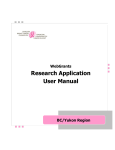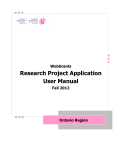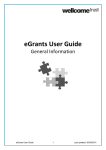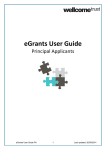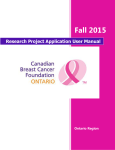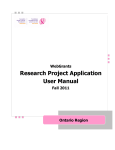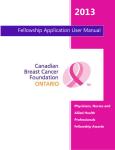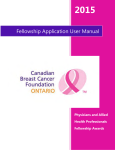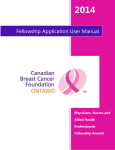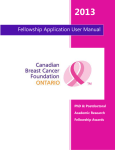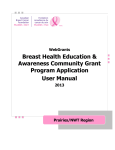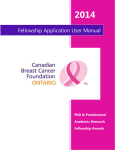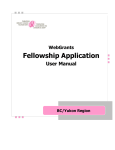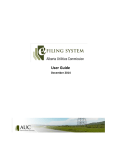Download 2015 Atlantic Research User Manual.doc
Transcript
WebGrants Research Project Application User Manual Atlantic Region Preparing an Application in WebGrants Copyright © 2013 Canadian Breast Cancer Foundation. All rights reserved. All company, product and service names may be trademarks or registered trademarks of their respective owner(s). Connections for Business Sales Preparing an Application in WebGrants TABLE OF CONTENTS 1. How to Apply for Research Project Funding ............................ 3 2. Preparing to Use the WebGrants System ................................ 5 3. Navigating WebGrants ......................................................... 100 4. Main Menu Instructions ......................................................... 14 5. Research Application Components ........................................ 18 5.1 – General Information ......................................................... 18 5.2 – Funding Duration .............................................................. 21 5.3 – CSO Coding ........................................................................ 22 5.4 – CSCC Coding ...................................................................... 23 5.5 – Resubmission (Past Project Information) ........................ 24 5.6 – Project Team ..................................................................... 25 5.7– Host Organization .............................................................. 29 5.8 – Locations of Project(s) ...................................................... 31 5.9 - Required Certificates/Approvals ....................................... 32 5.10 – Relation to Larger Initiative ........................................... 34 5.11 - Current and Pending Sources of Research Support ........ 37 5.12 - Scientific Abstract ............................................................ 40 5.13 – Lay Language Summary of Project ................................. 42 5.14 - Budget ............................................................................. 43 5.15 - Budget Justification ......................................................... 46 5.16 – Project Objectives (Aims) ............................................... 49 5.17 – Detailed Project Proposal ............................................... 50 5.18 - Knowledge Translation .................................................... 52 5.19 - Host Organization Certification ....................................... 55 5.20 - Suggested Reviewers to Include ..................................... 57 5.21 - Attachments .................................................................... 59 5.22 - Submitting Your Application for Assessment .................. 60 Appendix A: Common Scientific Outline (CSO) Codes ............... 61 Appendix B: Project Classification using the CSCC Analytic Framework ................................................................................................... 66 Canadian Breast Cancer Foundation © 2013 December 2013 WebGrants User Manual 1 Preparing an Application in WebGrants Canadian Breast Cancer Foundation © 2013 December 2013 WebGrants User Manual 2 Preparing an Application in WebGrants 1. How to Apply for Research Project Funding a) Download Research Grant Program Guidelines and Criteria from the CBCFAtlantic Region website and review in detail to determine whether your proposed project meets CBCF-Atlantic Region eligibility requirements. b) Use the Research Project Application User Manual as your guide to completing your application for funding. Together, the Research Project Grant Program Guidelines and Criteria and the Research Project Application User Manual provide all the information applicants require to submit an application for Research Project funding to CBCF-Atlantic Region. This manual provides a step-by-step guide for completing your application for Research Project funding online, using the WebGrants system. Applicants are strongly encouraged to begin the application process early. It is the applicant’s responsibility to ensure they allow sufficient time for securing required documents and signatures in time for submission by application deadlines. The Canadian Breast Cancer Foundation - Atlantic Region expects applicants to prepare competitive funding proposals that meet program criteria and formatting requirements, are clear and complete in all respects, and are free of error. The same meticulous attention to detail that is required for the preparation of a scientific paper for publication should be used by applicants in the preparation of their Research Project application to the Foundation. Applicants should: • carefully follow all instructions in this User Manual and refer to information provided in the Guidelines as appropriate • complete all application components, responding to all questions in each component • carefully review their entire application prior to submission In order to ensure fair treatment of all applicants, applications which are incomplete or do not adhere to specified criteria or formatting will be ineligible for peer review, without appeal. Canadian Breast Cancer Foundation © 2013 December 2013 WebGrants User Manual 3 Preparing an Application in WebGrants For Assistance Answers to most questions applicants may have will be found in the Research Grant Program Guidelines and Criteria and the Research Project Application User Manual. If, after consulting these reference documents, you have further questions or require additional assistance, or require help with technical aspects of the WebGrants system, please contact the CBCF-Atlantic Region office by e-mail – [email protected] E-mail is monitored during regular office hours (9am-5pm Atlantic, Monday to Friday). The Foundation will reply within one business day to all requests for assistance. Canadian Breast Cancer Foundation © 2013 December 2013 WebGrants User Manual 4 Preparing an Application in WebGrants 2. Preparing to Use the WebGrants System Overview This section explains the steps involved in gaining access to the WebGrants system. Set your web browser to: http://webgrants.cbcf.org/index.jsp Existing WebGrants Users Enter your User ID and Password to login. If you are unsure if you already have a WebGrants User Profile or have lost your password, please contact the Foundation for assistance: Angie McAuley 902-423-8274 or [email protected] 1. Go to Step 2 to update your User Profile. System Compatibility Step 1: Registering to become a WebGrants User To register with the WebGrants system, click the Register Here link on the Login page. Canadian Breast Cancer Foundation © 2013 December 2013 WebGrants User Manual 5 Preparing an Application in WebGrants Complete all asterisked Registration form. fields and as many optional fields as you can on the Eligible Registrants: Registration must be in the name of the proposed Principal Investigator. The Principal Investigator must be a Canadian citizen or permanent resident of Canada, based in, or formally affiliated with an eligible project host organization (university, college, hospital, research institute or other qualified not-for-profit organization) in the Atlantic Provinces and their primary professional practice must be within the Atlantic Provinces. The Canadian Breast Cancer Foundation © 2013 December 2013 WebGrants User Manual 6 Preparing an Application in WebGrants Principal Investigator will usually hold a Ph.D. or equivalent Medical Degree and have formal research training. Organization Information: Please provide the Principal Investigator’s primary organizational affiliation for research. CRA Business #/Charitable Registration #: Please indicate the CRA Business #/ Charitable Registration # of the primary organization the Principal Investigator is affiliated with. If the CRA Business # / Charitable Registration # is unknown, enter a single character in this field before saving. Region: Please indicate “Atlantic” from the drop-down list for the CBCF region affiliation. Degrees: Please list professional credentials (degrees, certifications and specialties) C.V.: Please upload a current CV. Acceptable CV’s are the CIHR Common CV, or any CV which includes the same information as found in the CIHR Common CV. When all entries are complete, Click the Register link. A confirmation page will be displayed and you will receive a confirmation email. However, you cannot log into the system at this time. CBCF must approve your registration before your user id and password will become active. Please allow one business day for processing of your registration request. You will receive another email when CBCF reviews your registration. If your registration has been approved, your user id and password will now be active and you may log into the system on the Login screen to complete Step 2: Updating your Grantee Profile. Canadian Breast Cancer Foundation © 2013 December 2013 WebGrants User Manual 7 Preparing an Application in WebGrants Step 2: Updating your WebGrants User Profile 1. After you have received an e-mail indicating that your WebGrants registration has been approved by CBCF, log in to the Login screen, click the My Profile icon from the Main Menu. 2. Click the Edit icon. 3. Review and confirm accuracy of profile information, and update as required. Canadian Breast Cancer Foundation © 2013 December 2013 WebGrants User Manual 8 Preparing an Application in WebGrants 4. Click the Save screen). button to return to the Main Menu (The My Profile main Canadian Breast Cancer Foundation © 2013 December 2013 WebGrants User Manual 9 Preparing an Application in WebGrants 3. Navigating WebGrants Overview This section provides basic information for applicants on how to navigate the WebGrants system. Basic Navigation Tools: The WebGrants Navigation Bar At the top of each WebGrants page are a series of icons representing action options or functions. Icons that are grayed out are not available at that time, for that screen. WebGrants Navigation Bar Icons The Menu icon returns the applicant to the WebGrants Main Menu. For more information, please see the section, Main Menu Instructions, in this User Manual. The Help icon opens a pop-up window with basic help information. If it does not contain the information you are seeking, please refer to this User Manual for help with specific components, or contact CBCF staff by e-mail at [email protected] for assistance. The Log Out icon is used to end the applicant’s WebGrants session. Logging out will not save entered information. You must Save the component on which you are working prior to logging out if you wish the entered information to be retained. The Back icon is used to go back, usually to the previously viewed page, sometimes to the Components Menu. Please note that using the Back icon will NOT save any new information entered on the current page. To keep information newly entered, please use the Save icon before going Back. The Print icon is active on pages which can be printed. This button will bring up a new window that will display the current screen’s contents in printer friendly format. To print the page, use the Print function in your internet browser. The Add icon is active when new entries can be made. It takes the applicant to a Canadian Breast Cancer Foundation © 2013 December 2013 WebGrants User Manual 10 Preparing an Application in WebGrants new screen to enter component information. Once information is entered, use the Save link (see below) to save the information entered and return to the current component. Sometimes summarized information will be displayed within the component. Should you wish to view the full entry, or edit the entry, click on the coloured (blue) text within the entry you wish to view or edit (see Linked Words or Phrases, below). To return to the component, use the Save icon again, or the Back icon. The Delete icon is used to delete all entered information for a particular component. The applicant will be prompted to confirm that they wish to delete the information, prior to execution of this command. The Edit icon is active when the contents of the page you are on can be changed. It takes the applicant to a new screen to enter component information. Once information is entered, use the Save link (see below) to save the information entered and return to the component. All entered information will be displayed on the component screen. The Save icon saves all entered information within a component, and takes the applicant back to the current component. Other Navigation Tools Linked Words or Phrases When a word or phrase is shown in underlined blue text, this indicates that this is a link. To see further information related to the word or phrase, click on the word. Clicking on a linked word or phrase will open a new screen with the linked information. This information is sometimes display-only, and sometimes editable using the Edit icon, as above. To return to the original screen, click Save or Back. Dropdown Menus For some items the applicant must select one of a number of optional responses. When this is the case, a shaded box with a down chevron will be displayed. Click on the chevron to display the available options and select the one which applies. Mark as Complete Applications are entered into WebGrants using “Components”, which are mini-modules containing grouped information. Applicants are recommended to use the Component List as their main navigation point when entering applications, accessing and completing each component from this List. Components can be completed in any order. On all individual component screens there is a “Mark as Complete” link on the right hand side of the screen. The “Mark as Complete” function is used to track which components you have completed and finished editing. Clicking the “Mark as Complete” link will activate a checkmark for that component on the Application Forms Screens. You can still return to components that have been marked as complete for further editing prior to submitting your application as required. All components must be completely filled out and “Marked as Complete” before your application can be submitted to the Foundation for assessment. Clicking on this link will complete the Canadian Breast Cancer Foundation © 2013 December 2013 WebGrants User Manual 11 Preparing an Application in WebGrants component and take the applicant back to the Components Menu screen. Masks Some items require the applicant to enter information in a specific format, which is indicated through the use of a “mask”. One such item is “Phone/Fax” (ie. this field is pre-formatted to provide dashes between each set of numbers). Please confirm that your information entered correctly within these items. Attaching Documents or This function is accessed by clicking the Add Icon, or the Attach Icon, depending on the component screen being utilized. Some components require the entry of a brief file description for clarity, when more than one file can be uploaded. Where indicated, the file description field must be filled out. The “Browse” button is used to find the file to be attached, and the “Upload File” or “Save” Icon will save the file to the WebGrants system. Allowable File Formats: Adobe Acrobat (.pdf) only Deleting Attachments On screens where you have attached a document, clicking on the Delete Attachment icon will remove your document. This will allow you to re-attach a new document. Radio Buttons On some component screens the applicant must select from among a number of optional responses using radio buttons. In some case only one response is permitted; in other cases multiple responses are allowed. Please see individual component instructions regarding what is permitted for any given item. To select the desired response, click on the button by that response. Entering Dates On some component screens applicants are required to enter specific dates. When this is required, a calendar icon will be displayed. Click on the calendar icon and, using the arrows at the top to scroll through the months and years, click on the desired date. Certification Pages Certification pages are required documents. To complete these components, the applicant must download the certification form from WebGrants. These forms should be printed, completed by the applicant, signed by the appropriate individuals, scanned, and saved into the application using the Browse and Attach button, as above. Where two signatures are required on one form (for Host Organization, for example), if it is necessary to use two hard copies to obtain the two signatures, please scan the two pages into one document and attach as a single attachment. Canadian Breast Cancer Foundation © 2013 December 2013 WebGrants User Manual 12 Preparing an Application in WebGrants Other Important Information Completeness All questions are mandatory and must be answered in order for your application to be complete and be submitted to CBCF for review unless otherwise indicated in the instructions for that component. You may use the “Mark as Complete” function to enable the submission of your application on optional screens that have not been filled out. Character Counts Text box entry fields have preset maximum character counts. Character count maximums for larger entry fields will be indicated in the User Manual. The maximum character counts indicated include both characters and spaces. Should you encounter an error in saving data entered into a text box, consider whether you may have exceeded the maximum character count, and edit your entry before clicking Save. Fonts and Scientific Characters It is recommended that applicants “cut & paste” larger text entries into WebGrants. WebGrants will maintain the font and formatting of the original text. Please prepare entries for text boxes using Arial 10pt font and any fonts or formatting required for scientific characters. WebGrants Passwords If you forget your WebGrants password, click the Forgot Password link on the Login screen. Enter your user id and email address in the displayed form and click Submit. Your password will be emailed to you at the email address in your profile. If you want to change your password, Login to the WebGrants system, click on the My Profile icon. Click the Reset Password link. Enter and confirm the new password. Click the Save button. Canadian Breast Cancer Foundation © 2013 December 2013 WebGrants User Manual 13 Preparing an Application in WebGrants 4. Main Menu Instructions Overview This section provides an overview of the Main Menu screen and the Components found there. Main Menu The modules displayed on the main menu are as follows: Instructions To access the WebGrants Instructions screen, click the Instructions link. The Instructions page includes information on general navigation, the Main Menu screen, and each of the links found on the Main Menu screen. The Instructions document can be printed using the Print button, if desired. My Profile This module allows you to edit your personal contact information as well as reset your password. Please see “Updating Your Grantee Profile” on page 8, for more information. Canadian Breast Cancer Foundation © 2013 December 2013 WebGrants User Manual 14 Preparing an Application in WebGrants Funding Opportunities To View Funding Opportunities (Calls for Proposals) available in Atlantic Region, click the Funding Opportunities button. This will display a list of all open opportunities, their Program Areas, and Proposal Deadlines. Applicants whose primary professional practice is in the Atlantic Region may apply for Funding Opportunities identified within the Atlantic Region only at this time. To view a particular Funding Opportunity, click on the Opportunity Title. A screen with Opportunity Details will be displayed. The Grant Program Guidelines and Criteria and the Application User Manual can be accessed from this page. Also displayed will be titles and status of any applications you may already have made to this Opportunity. This screen can be printed using the print function of your web browser. Canadian Breast Cancer Foundation © 2013 December 2013 WebGrants User Manual 15 Preparing an Application in WebGrants To Apply to a particular Funding Opportunity, click the Start a New Application link. This will take you directly to the first Application Component to begin entering your application. My Applications The My Applications module displays a list of all recent applications, and shows the current status of each (Editing, Submitted, Correcting, Under Review, Approved). To view applications in other statuses, click on the Archived Applications link. Canadian Breast Cancer Foundation © 2013 December 2013 WebGrants User Manual 16 Preparing an Application in WebGrants Clicking on an application's title will display the application, in black and white, in a pop-up window. My Grants The My Grants screen displays titles of funded applications (Awards) from the Fall 2008 grant call forward. The initial page displays grants with the status Underway and Suspended. Clicking on the Closed Awards link will display grants with the status Closed and Archived. Clicking on a grant's title will display the grant components. This module will be used for progress reporting, payment processing and communication with CBCF during the funding period for new grants approved in spring 2009 and forward. Canadian Breast Cancer Foundation © 2013 December 2013 WebGrants User Manual 17 Preparing an Application in WebGrants 5. Research Application Components 5.1 – General Information This is the initial step to completing a research grant application. You will be providing general information including the full scientific title of your project for which funds are being requested. 1. Login to the Main Menu. 2. Click on the Funding Opportunities icon from the Main Menu. 3. Choose the Funding Opportunity from the list of available options. Canadian Breast Cancer Foundation © 2013 December 2013 WebGrants User Manual 18 Preparing an Application in WebGrants 4. Click Start a New Application at the top of the screen to create an application for this funding opportunity. Canadian Breast Cancer Foundation © 2013 December 2013 WebGrants User Manual 19 Preparing an Application in WebGrants 5. Enter the full scientific Project Title for your research project. 6. The name of the Host Organization you provided on the “My Profile” page will automatically appear in this field. 7. Click on the Save icon to save the information you have entered. 8. To edit the title of the project from the main menu choose funding opportunities, opportunity title, application title, general information, edit. 9. To continue filling out the application click the Go to Application Forms link in the middle of the screen. Canadian Breast Cancer Foundation © 2013 December 2013 WebGrants User Manual 20 Preparing an Application in WebGrants 5.2 – Funding Duration 1. Click on the Funding Duration component from the list. 2. Use the drop down menu to choose the Funding Duration Requested (1 or 2 years). 3. Click on the Save you have entered. icon at the top of the page to save the information 4. Click on the Mark as Complete link to complete this component and to return to the Components menu. Canadian Breast Cancer Foundation © 2013 December 2013 WebGrants User Manual 21 Preparing an Application in WebGrants 5.3 – CSO Coding Adding CSO (Common Scientific Outline) Codes 1. Click on the CSO Coding component from the list. 2. Use the drop down lists to choose three different, sub/numerical CSO Codes that best describe the Primary, Secondary and Tertiary focus areas of the project for which funds are being requested. (See Appendix A for more detailed CSO Code descriptions) 3. Click on the Save icon at the top of the page to save the information you have entered. 4. Click on the Mark as Complete link to complete this component and to return to the Components menu. Canadian Breast Cancer Foundation © 2013 December 2013 WebGrants User Manual 22 Preparing an Application in WebGrants 5.4 – CSCC Coding CSCC Codes (Adapted from “Analytic Framework for Cancer Control in Canada”, NCIC) 1. Click on the CSCC Coding component from the list. 2. Use the drop down menus to choose up to three, different CSCC Codes that best describe the Primary, Secondary and Tertiary focus areas of the project for which funds are being requested. (See Appendix B for more detailed Code Descriptions) 3. Click on the Save you have entered. icon at the top of the page to save the information 4. Click on the Mark as Complete link to complete this component and to return to the Components menu. Canadian Breast Cancer Foundation © 2013 December 2013 WebGrants User Manual 23 Preparing an Application in WebGrants 5.5 – Resubmission (Past Project Information) Applicants re-submitting proposals that were considered but not funded in a prior funding Call for Proposals must clearly and directly respond to review panel feedback from the prior Call, in the space provided. 1. Click on the Resubmission component from the list. 2. Indicate whether or not this project is a resubmission of a previously reviewed proposal, using the radio buttons provided. 3. If “no”, proceed to Step 4. If “yes”, use the text box to: • “Cut and Paste” prior reviewer feedback • Provide Applicant’s response to this feedback. Please limit your response to 10,000 characters. Note: Applicants may attach supporting documents related to their response (references, tables, etc.) in the Attachment component. If including attachments, please clearly indicate their file name(s) as the last item at the bottom of the text box so peer reviewers can easily find the correct attachment for this component. Canadian Breast Cancer Foundation © 2013 December 2013 WebGrants User Manual 24 Preparing an Application in WebGrants File Naming Convention: Additional Documents Related to Resubmission : [resubmission #.doc or resubmission #.pdf] 4. Click on the Save you have entered. icon at the top of the page to save the information 5. Click on the Mark as Complete link to complete this component and to return to the Components menu. 5.6 – Project Team In this component, applicants must list all members of the project team along with their contact information, responsibilities in the project, and attach a C.V. for the Principal Investigator, all Co-Applicants, Additional Authors, Research Associates or Letter of Collaboration (Project Collaborators). 1. Click on the Project Team component from the list. 2 Click on the Add Canadian Breast Cancer Foundation © 2013 December 2013 icon at the top of the screen. WebGrants User Manual 25 Preparing an Application in WebGrants 2. Enter the Prefix, First and Last Name of the project team member. Indicate the person’s Title. 3. Use the drop down menu to indicate this project team member’s Role in Project. Co-Applicant - Co-Applicants are researchers who may or may not have a formal affiliation with the project host organization, but will take responsibility for particular administrative and scientific aspects of the research project. CoApplicants are not eligible to receive salary support from a CBCF – Atlantic Region research project grant. Students, fellows or technicians may not be designated as Co-Applicants. Canadian Breast Cancer Foundation © 2013 December 2013 WebGrants User Manual 26 Preparing an Application in WebGrants Additional Author/Research Associate - Additional Authors and Research Associates are individuals who will make substantial intellectual and/or functional contributions to the research project or have contributed to the drafting of the application, but are not eligible to be included as Co-Applicants. Additional Authors and Research Associates may receive salary support or honoraria from the grant in keeping with host organization rates and policies. Collaborator - The project design may include research collaborators who are central to the research and not otherwise identified in the categories above. Such collaborators may be located within, or outside of the Atlantic Region. Research collaborators are eligible to receive project funds for specified services or resources if it can be demonstrated that their contribution is essential to the work being undertaken and not otherwise available to the project team. 4. Fill out the project team member’s Departmental Affiliation/ Phone/ Fax/and Email. 5. Indicate the Organization’s Name and Address related to this project team member. 6. Enter or “cut and paste” the project team member’s Responsibilities in this project in the text box provided. 7. Click on the Save icon to save the information you have entered. 8. Repeat steps 2-8 for each Project Team Member. 9. In the middle of the screen, click on the Attach and icons and use the “browse and attach” function to attach C.V. files and Team Member Signature Templates for the Principal Investigator, each CoApplicant, Additional Author, and/or Research Associate, and Letters of Collaboration from each Collaborator. Curriculum Vitae (CV) Requirements – Acceptable CV’s are the CIHR Common CV, or any CV which includes the same information as found in the CIHR Common CV. Applicants are advised to detail any interruptions in their scientific career for information of reviewers. Collaborator Letter Requirements - Collaborator letters must confirm the collaborator’s contribution to the project, stating the supplies, services and/or expertise to be provided. It is the Principal Investigator’s responsibility to demonstrate the anticipated contribution(s) of the collaborator(s) toward the Canadian Breast Cancer Foundation © 2013 December 2013 WebGrants User Manual 27 Preparing an Application in WebGrants goals of the project within the detailed project proposal. File Naming Convention: CV’s: [surname-cv.doc or surname-cv.pdf] Letters of Collaboration: [surname-collab.doc or surname-collab.pdf] 10. When all teams members attachments have been saved, click on the Mark as Complete link to complete this component and to return to the Components menu. Canadian Breast Cancer Foundation © 2013 December 2013 WebGrants User Manual 28 Preparing an Application in WebGrants 5.7 – Host Organization CBCF-Atlantic Region requires the identification of an eligible Project Host Organization within the Atlantic Provinces, to administer the proposed project if funded. Click on the Host Organization component from the list. 1. Enter the name of the Financial Department that will be receiving grant payments and tracking expenditures if your project is funded. 2. Indicate the name of the Host Organization in the “Institution” field. 3. Fill out the Address information related to the Financial Department of the Host Organization (Address/City/Postal code/Country). Canadian Breast Cancer Foundation © 2013 December 2013 WebGrants User Manual 29 Preparing an Application in WebGrants 4. Enter the Institution’s CRA Business # / Charitable Registration#. 5. Click on the Save icon to save the information you have entered. 6. Click on the Mark as Complete link to complete this component and to return to the Components menu. Canadian Breast Cancer Foundation © 2013 December 2013 WebGrants User Manual 30 Preparing an Application in WebGrants 5.8 – Locations of Project(s) Research Projects must be conducted within settings providing the facilities and staff necessary to support the requirements of the Detailed Project Proposal. Provide all locations, including Host Organization facilities, where proposed work will take place. 1. Click on the Locations of Project(s) component from the list. 2. Click on the Add icon at the top of the screen. 3. In the Location of Work field provide the name of the primary location where project activities/training will take place. 4. Click the Save location. icon at the top of the screen to complete this 5. Repeat numbers 2-4 for each additional location. 6. Click on the Mark as Complete link to complete this component and to return to the Components menu. Canadian Breast Cancer Foundation © 2013 December 2013 WebGrants User Manual 31 Preparing an Application in WebGrants 5.9 - Required Certificates/Approvals Indicate all required certificates and approvals (e.g. Ethical Approval Certificate for Research Involving Humans, Animal Care Approval, Biohazard/Biosafety Approval, Radiation Safety Approval, Community Based Ethics Board Approval, or “Other”) for research being proposed. 1. Click on the Required Certificates/Approvals component from the list. 2. Click on the Add Canadian Breast Cancer Foundation © 2013 December 2013 icon at the top of the screen. WebGrants User Manual 32 Preparing an Application in WebGrants 3. Use the drop down menu to indicate the first Certificate Type. 4. Indicate the certificate’s Approval Date using the calendar function. 5. Indicate the certificate’s Expiration Date using the calendar function. 6. Enter the name of the Issuing Institution. 7. Enter the certificate’s Protocol Number. 8. If certificate type Other was selected in step 3 above, please provide a description of the certificate and the applicable location in the textbox provided. 9. Click on the Save each certificate. icon at the top of the page to complete details for 10. Click on the Mark as Complete link to complete this component and to return to the Components menu. Canadian Breast Cancer Foundation © 2013 December 2013 WebGrants User Manual 33 Preparing an Application in WebGrants 5.10 – Relation to Larger Initiative Relation of current application to larger initiative(s). 1. Click on the Relation to Larger Initiative component from the list. 2. Click on the Add icon on the top of the screen. 3. Indicate whether or not this project is a component of a larger initiative. If icon at the top of the page and click on the “no”, click on the Save Mark as Complete link to complete this component and return to the Canadian Breast Cancer Foundation © 2013 December 2013 WebGrants User Manual 34 Preparing an Application in WebGrants Components menu. 4. If “yes” is chosen, provide a Description in the text box explaining how the requested funding will support distinct and unique components that are not otherwise funded. 5. Click on the Save icon at the top of the page. 6. Click on the Attach icon to the right of the page and use the “browse and attach” function to attach a one page Scientific Abstract for the Larger Initiative. 7. Click on the Mark as Complete link to complete this component and return to the Components menu. Canadian Breast Cancer Foundation © 2013 December 2013 WebGrants User Manual 35 Preparing an Application in WebGrants 5.11- Current and Pending Sources of Research Support Please indicate the Principal Investigator’s current and pending sources of research support in this component. 1. Click on the Current and Pending Sources of Research Support component from the component list. 2. Click on the Add icon at the top of the screen (if there are no other sources of funding, click “Mark as Complete” and return to the Application menu). Canadian Breast Cancer Foundation © 2013 December 2013 WebGrants User Manual 37 Preparing an Application in WebGrants 2. Fill out the Project Title and Funding Source. 3. Indicate the Date Funding was Received (or is anticipated) by choosing the date using the calendar function. 4. Indicate the Date Funding Concludes (or you anticipate it will conclude) by choosing the date using the calendar function. 5. Using the drop-down menu, indicate whether this project potentially overlaps with the current application with respect to “Activities”, “Budget”, “Both”, or “None”. 6. Indicate % of Principal Investigator’s professional time committed to this initiative (or anticipated, if support is pending). Canadian Breast Cancer Foundation © 2013 December 2013 WebGrants User Manual 38 Preparing an Application in WebGrants 7. Indicate % of potential overlap between this project and the current application, and describe the nature of the potential overlap in the text box provided. 8. Enter the amount of funding Requested or Received. 9. Click the Save icon at the top of the screen to finish entering this source of funding. 10. Click on the Attach icon to the right of the screen and use the “browse and attach” function to attach a scientific summary for each listed current or pending source of research support. 11. Click on the Attach icon to the right of the screen and use the “browse and attach” function to attach a budget summary for each listed current or pending source of research support. 12. Repeat numbers 2-11 for each Current or Pending Source of Support. 13. Click on the Mark as Complete link to complete this component and return to the Components menu. Canadian Breast Cancer Foundation © 2013 December 2013 WebGrants User Manual 39 Preparing an Application in WebGrants 5.12 - Scientific Abstract Please provide a detailed Scientific Abstract which clearly states the nature of the problem to be investigated, project objectives, methodologies to be used, as well as the significance of the research to breast cancer. Ensure that specified character counts are adhered to. 1. Click on the Scientific Abstract component from the list of components. Canadian Breast Cancer Foundation © 2013 December 2013 WebGrants User Manual 40 Preparing an Application in WebGrants 2. Enter all Investigator(s)/Departmental Affiliation/Organization that are involved in your project, separated by a semi-colon, in the text box provided. 3. Fill in the Title of the Project. 4. Enter up to five Keywords that describe the scientific and technical aspects of the project. 5. Enter or “cut and paste” the Scientific Abstract in the text box provided. (“Cut and paste” is recommended. Please use Arial 10 pt. font, singlespaced). The text box will accept a maximum of 3800 characters (including spaces). 6. Click on the Save icon to save the information you have entered. 7. Click on the Mark as Complete link to complete this component and return to the Components menu. Canadian Breast Cancer Foundation © 2013 December 2013 WebGrants User Manual 41 Preparing an Application in WebGrants 5.13 – Lay Language Summary of Project Lay Language Summary of the Project 1. Click on the Lay Language Summary of Project component from the list of components. 2. Enter a summary of the project in Lay Language in the text box provided. Describe the project context, objectives, methodologies, relevance and anticipated impact on the issue of breast cancer. Describe how the project relates to the Foundation’s mission. This summary will be used to describe the project to the Foundation’s stakeholders. The text box will accept a maximum of 1500 characters (including spaces). 3. Click on the Save you have entered. icon at the top of the page to save the information 4. Click on the Mark as Complete link to complete this component and return to the Components menu. Canadian Breast Cancer Foundation © 2013 December 2013 WebGrants User Manual 42 Preparing an Application in WebGrants 5.14 - Budget 1. Click on the Budget component from the list. Budget items are segmented into – “Supplies & Services”, and “Human Resources”. Note: Please fill out the number of budget columns that match the duration of your proposed project. The budget may not exceed $50,000 per year for a total project budget of $150,000 over 3 years. Please ensure that budget items are eligible with the program criteria outlined below. Items that do not meet eligibility criteria or are unclear are subject to reduction or deletion by peer reviewers. The Foundation seeks to fund projects at an appropriate level for the work being proposed and places an emphasis on well-justified and realistic project budgets. 2. Click the Add link to enter Supplies and Services. Canadian Breast Cancer Foundation © 2013 December 2013 WebGrants User Manual 43 Preparing an Application in WebGrants 3. Enter the Item Name for the supply or service into the Item Name field. 4. Use the drop down menu to indicate the Classification for this item. The Drop-Down menu choices for eligible costs are: Supplies – Direct project-related supplies and consumables Services – Direct project-related services Travel – Direct project-related travel and meetings (do not include travel for conferences, seminars or project dissemination under this classification) Dissemination Printing Patient Related Costs Other 5. Enter a Description for each “Supplies and Services” item in the text box provided. 6. Enter the cost of each item for every Year of the Project. 7. Click the Save icon to add each item to the budget. 8. Repeat number 2-7 for each Supply and Service item. 9. Click the Add link to enter Human Resources (Salaries and Wages). Canadian Breast Cancer Foundation © 2013 December 2013 WebGrants User Manual 44 Preparing an Application in WebGrants 10. Use the drop-down menu to indicate the Classification of the staff being added. The drop-down menu choices are: Student, Fellow, Research Associate/Assistant, Technician, Consultant, Contractor, Project Staff, Other) 11. Indicate the Name of the Person in this role. (This is a required field) (If unknown at the time of application, enter “To Be Determined”). 12. Enter the salary and benefits cost related to this role for every Year of the Project. • Note: Payments must conform to the usual rate for similar roles within the organization in which the work will be carried out. The Foundation does not pay CPP, Employment Insurance, health taxes, WSIB or any fringe benefits for stipends and training awards to students and research fellows; salary or professional fees for the Principal Investigator or Co-Applicants; or salaries for support staff unless such staff will be working directly on the proposed project. 13. Click the Save icon to add this item to the budget. 14. Repeat number 9-13 for all Salaries and Wages for the project (one entry for each individual to be paid from the project budget). Canadian Breast Cancer Foundation © 2013 December 2013 WebGrants User Manual 45 Preparing an Application in WebGrants 5.15 - Budget Justification In this component, you are asked to provide a detailed budget narrative, fully explaining and justifying each item in the budget for the first year, and explain any additional items in the budget for subsequent years, if applicable. Include quantity/price calculations to illustrate how budget line items were determined. Please include a description of responsibilities for all positions listed, along with justification of all expenditures listed. Items that are not calculated accurately or are not adequately justified may be subject to deletion or reduction by the review panel. 1. Click on the Budget Justification component from the list of components. 2. Click the Edit icon. Canadian Breast Cancer Foundation © 2013 December 2013 WebGrants User Manual 46 Preparing an Application in WebGrants 3. Type or copy and paste your detailed budget narrative into the Budget Justification field box provided. 4. Click on the Save icon to save the information you have entered. Budget Justification Attachments 5. You may click on the Add link to the right of the screen to add required attachments. 6. In the text box explain the Description of the file being uploaded. (This description is required). Canadian Breast Cancer Foundation © 2013 December 2013 WebGrants User Manual 47 Preparing an Application in WebGrants 7. Click on the Save icon to save the information you have entered. 8. Click on the Attach icon to the right of the screen and use the “browse and attach” function to attach your document. File Naming Convention – Supporting Documents: [Budget Item.pdf] 9. Repeat steps 5-8 for each budget justification attachment. 10. Click on the Mark as Complete link to complete this component and return to the Components menu Canadian Breast Cancer Foundation © 2013 December 2013 WebGrants User Manual 48 Preparing an Application in WebGrants 5.16 – Project Objectives (Aims) This section carries forward to be completed as part of the final report. Objectives and aims should be the same as in the detailed project proposal. 1. Click on the Project Objectives component from the list. 2. Click on the Add icon at the top of the screen. 3. Indicate the first Objective/Aim in the Project Aim field (copied from your detailed project proposal). 4. Describe your Project Aim in the text box provided. 5. Click the Save Canadian Breast Cancer Foundation © 2013 December 2013 icon to finish entering this Project Aim. WebGrants User Manual 49 Preparing an Application in WebGrants 6. Repeat steps 2-4 for each Project Objective (Aim). 7. Click on the Mark as Complete link to complete this component and return to the Components menu. 5.17 – Detailed Project Proposal Applicants must prepare the detailed project proposal using the Proposal Outline and required formatting that is detailed below. In fairness to all applicants, Detailed Project Proposals varying from the prescribed formatting standards will be ineligible for peer review without appeal. 1. Click on the Detailed Project Proposal component from the list of components. 2. Click on the Add icon at the top of the screen. 3. Use the Browse function to attach the Detailed Project Proposal to the application. Required Formatting – Detailed Project Proposal: Written text of up to a maximum of ten (10) numbered pages, not including references, double-spaced with 12-point font (Times New Roman). Condensed Canadian Breast Cancer Foundation © 2013 December 2013 WebGrants User Manual 50 Preparing an Application in WebGrants fonts or condensed character spacing may not be used. • • • • • Every page of text must display clearly visible line numbers in the left margin and each page must be numbered independently (ie. each page starts with line ‘1’). No page may exceed 23 lines. Side margins must be 1”. Top and bottom margins should be adjusted to ensure 23 lines per page, as above. Attach proposal references, and list of Definitions for Acronyms used within the detailed proposal. Applicants may attach, in a separate file, a maximum of up to five (5) pages of figures/tables/charts and associated legends. The associated legends must contain only the information necessary to understand the data being presented and not be used to circumvent the detailed proposal page length limitations. All of the above information must be compiled and saved as one file. File Naming Convention – Detailed Project Proposal: [PI Last Name Detailed Proposal .pdf] 4. In the text box explain the Description of the file being uploaded. (This description is required). 5. Click the Save icon to save the information you have entered. Applicants may attach, in a separate file, a maximum of up to five (5) pages of figures/tables/charts and associated legends. The associated legends must contain only the information necessary to understand the data being presented and not be used to circumvent the detailed proposal page length limitations. File Naming Convention – Figures/Tables/Charts: [PI Last Name Figures Tables.pdf] If the project methodology includes the use of Study Surveys and Questionnaires, please save these items separately. File Naming Convention – Study Surveys and Questionnaires: [Survey Questionnaire #.pdf] No other background materials or additional information may be attached to this application component. Additional information in support of the application may be saved in “Attachments” component, which is located as the last of the Application Forms. Applicants are advised that peer reviewers are not obligated to review information saved in the “Attachments” component. 6. Click on the Mark as Complete link to complete this component and return to the Components menu. Canadian Breast Cancer Foundation © 2013 December 2013 WebGrants User Manual 51 Preparing an Application in WebGrants 5.18- Knowledge Translation Applicants must describe how project knowledge will be transferred/disseminated to appropriate audiences. (Note: The Foundation is supportive of a budget of $2,500 towards knowledge translations). Knowledge Translation is also a component of the Detailed Project Proposal, you can “cut and paste” this section from your proposal into the text box provided in this component. 1. Click on the Knowledge Translation component from the list of components. 2. Click on the Edit Canadian Breast Cancer Foundation © 2013 December 2013 icon at the top of the screen. WebGrants User Manual 52 Preparing an Application in WebGrants 3. Describe the Knowledge Translation Strategy in the text box provided. 4. Click on the Save icon to save the information you have entered. Canadian Breast Cancer Foundation © 2013 December 2013 WebGrants User Manual 53 Preparing an Application in WebGrants 5. Click on the Add link to the right of the screen to add Method and Intended Audience. 6. Choose the Method of Knowledge Translation using the drop down menu. 7. Enter the Intended Audience for the Knowledge Translation. 8. Click on the Save icon to finish entering this activity. 9. Repeat steps 5-7 for each additional activity. 10. Click on the Mark as Complete link to complete this component and return to the Components menu. Canadian Breast Cancer Foundation © 2013 December 2013 WebGrants User Manual 54 Preparing an Application in WebGrants 5.19 - Host Organization Certification This application component is used to attach certification, through signatures from two Project Host Organization signing officers (Department Head or Dean and Executive Authority) that the Project Host Organization: • Agrees to support the applicant as outlined within the application, and to abide by the funding terms as outlined in the Research Program Guidelines, if funding is approved • Confirms that the information in the application is accurate and complete to the best of their knowledge. The Certificate template is to be downloaded directly from this component, and should be completed, signed, scanned, and attached to this component. Where two printed copies have been signed (one by each signatory), these documents should be scanned into one file for uploading into WebGrants. Applications without all required signatures, declarations and certifications will be ineligible for review. 1. Click on the Host Organization Certification component from the Application page. 2. Click the link to download the Host Organization Signatures Template. 3. Print the Host Organization Signatures Template. Have the Canadian Breast Cancer Foundation © 2013 December 2013 WebGrants User Manual 55 Preparing an Application in WebGrants Department Head or Dean and Executive Authority fill out and sign this form. 4. Scan and save the completed and signed Host Organization Signatures Template on your local computer. 5. Click on the Save icon at the top of the screen. 6. Use the Browse function to attach the Host Organization Signatures Template to the application. 7. In the text box explain the Description of the file being uploaded. (This description is required). 8. Click on the Mark as Complete link to complete this component and return to the Components menu. Canadian Breast Cancer Foundation © 2013 December 2013 WebGrants User Manual 56 Preparing an Application in WebGrants 5.20 - Suggested Reviewers to Include (optional) This section is to be filled out only if the expertise to review your grant application does not reside in Atlantic Canada, and you would like to suggest Canadian experts for the CBCF to approach to review your grant application. 1. Click on the Suggested Reviewers to Include component from the list. 2. This is an optional component. If you do not have any reviewers to suggest, please select “Mark as Complete”. 3. Otherwise, click on the Add Canadian Breast Cancer Foundation © 2013 December 2013 icon at the top of the screen. WebGrants User Manual 57 Preparing an Application in WebGrants 4. Use the drop down menu to indicate the Reviewer’s Prefix. 5. Fill out the Reviewer’s First and Last Name and Organization. 6. Indicate the Reviewer’s full Address. (Address/City/Postal Code/Country) 7. Enter the Reviewer’s Department. 8. Fill out the Reviewer’s Phone/Fax Numbers. 9. Enter into the appropriate field the Reviewer’s Email address. 10. Specify the Reviewer’s Areas of Expertise. 11. Click the Save icon to finish including this Reviewer. 12. Repeat number 3-12 for each additional Reviewer. 13. Click on the Mark as Complete link to complete this component and return to the Components menu. Canadian Breast Cancer Foundation © 2013 December 2013 WebGrants User Manual 58 Preparing an Application in WebGrants 5.21 – Attachments (optional) This component is used to attach other background materials or supporting documents. Please be advised that peer reviewers are not obligated to review these materials. 1. Click on the Attachments component from the list. 2. Click on the Add icon at the top of the screen. 3. Use the Browse function to attach your document. 4. In the text box explain the Description of the file being uploaded. (This description is required). 5. Click the Save file. icon at the top of the screen to finish attaching this 6. Repeat numbers 2-5 for each additional attachment. 7. Click on the Mark as Complete link to complete this component and return to the Components menu. Canadian Breast Cancer Foundation © 2013 December 2013 WebGrants User Manual 59 Preparing an Application in WebGrants 5.22 - Submitting Your Application for Assessment When you have completed all required application components and attachments, it is recommended that you review the application in detail to confirm that no information is missing, and no further edits are required. The application can be reviewed, looking at each component individually or by clicking “Application Preview” from the Main Application menu. In Application Preview mode, you will be able to click on the links to all attachments to ensure that they are complete. Please make sure that all components are “Marked as Complete”. When you have finished reviewing your application, click the “Submit” button on the Main Application Menu. You will receive an error message if any component required fields are not complete. Enter any missing information and click the “Submit” button again to submit the application to CBCF for assessment. You will receive an auto-generated system message that your application has been successfully submitted. After submitting your application to CBCF all screens become locked. You will be able to view your application but will not be able to make any further changes. Printing Attachments to the application are printed separately. Only links will show in the main document. Canadian Breast Cancer Foundation © 2013 December 2013 WebGrants User Manual 60 Preparing an Application in WebGrants Appendix A: Common Scientific Outline (CSO) Codes “Common Scientific Outline” (NCI) Coding System Biology of Breast Cancer (CSO Code 1.0) • • • Cancer initiation: Alterations in Chromosomes (CSO Code 1.2) o Examples: Abnormal chromosome number; Aberration in chromosomes and genes; Damage to chromosomes and mutation in genes; Failures in DNA repair; Aberrant gene expression; Epigenetics; Genes and proteins involved in aberrant cell cycles Cancer initiation: Oncogenes and Tumour Suppressor Genes (CSO Code 1.3) o Examples: Genes and signals involved in growth stimulation or repression including oncogenes and tumour suppressor genes; Effects of hormones and growth factors and their receptors such as estrogens, androgens, TGF-beta, GMCSF, etc. Cancer progression and metastasis (CSO Code 1.4) o Examples: Latency, promotion and regression; Expansion of malignant cells; Interaction of malignant cells with the immune system or extracellular matrix; Cell mobility including detachment, motility and migration in the circulation; Invasion; Malignant cells in the circulation including penetration of the vascular system and extravasation; Systemic and cellular effects of malignancy; Tumor angiogenesis and growth of metastases; Role of hormone or growth factor dependence/independence in cancer progression Etiology (CSO Code 2.0) • • • Exogenous Factors in the origin and cause of breast cancer (CSO Code 2.1) o Examples: Modifiable lifestyle factors; Environmental and occupational exposures to chemical or physical agents; Infectious agents associated with breast cancer etiology, including viruses and bacteria; Viral oncogenes and viral regulatory genes associated with breast cancer causation Endogenous factors in the origin and cause of breast cancer (CSO Code 2.2) o Examples: Free radicals; Genes known to be involved or suspected of being mechanistically involved in familial cancer syndromes; Genes suspected or known to be involved in “sporadic” cancer events (i.e. polymorphisms and/or mutations that may affect carcinogen metabolism) Interactions of genes and/or Genetic Polymorphisms with Exogenous and/or Endogenous Factors (CSO Code 2.3) o Examples: Gene-environment interactions; Interactions of genes with lifestyle factors and environmental and/or occupational exposures such as variations in carcinogen metabolism associated with genetic polymorphisms; Interactions of Canadian Breast Cancer Foundation © 2013 December 2013 WebGrants User Manual 61 Preparing an Application in WebGrants genes and endogenous factors such as DNA repair deficiencies and endogenous DNA damaging agents such as oxygen radicals or exogenous radiation exposure Prevention (CSO Code 3.0) • • • • • Interventions to Prevent Cancer: Personal Behaviours that Affect Cancer Risk (CSO Code 3.1) o Examples: Research on determinants of personal behaviours that affect cancer risk; Interventions to change personal behaviours that affect cancer risk Nutritional Science in Cancer Prevention (CSO Code 3.2) o Examples: Quantification of nutrients and micronutrients; Studies on the effect(s) of nutrients or nutritional status on cancer incidence; Dietary assessment efforts including dietary questionnaires and surveys; Development, characterization and validation of dietary/nutritional assessment instruments Chemoprevention (CSO Code 3.3) o Examples: Chemopreventive agents and their discovery, mechanism of action, development, testing in model systems and clinical testing Vaccines (CSO Code 3.4) o Examples: Vaccines for prevention; vaccine discovery, mechanism of action, development, testing in model systems and clinical testing Complementary and Alternative Prevention Approaches (CSO Code 3.5) o Examples: Discovery, development and testing of complementary/alternative prevention approaches such as diet, herbs, supplements or other interventions that are not widely used in conventional medicine or are being applied in different ways as compared to conventional medical uses; hypnotherapy, relaxation, transcendental meditation, imagery, spiritual healing, massage, biofeedback, etc. used as a preventive measure Early Detection, Diagnosis, Prognosis (CSO Code 4.0) • • • Technology Development and/or Marker Discovery (CSO Code 4.1) o Examples: Discovery of markers (i.e. proteins, genes) and/or technologies (such as fluorescence, nanotechnology, etc.) that are potential candidates for use in cancer detection, staging, diagnosis and/or prognosis; Use of proteomics, genomics, expression assays or other technologies in the discovery of markers Technology and/or Marker Evaluation with Respect to Fundamental Parameters of method (CSO Code 4.2) o Examples: Development, refinement and preliminary evaluation (i.e. animal trails and Phase I human trials); Preliminary evaluation with respect to laboratory sensitivity, laboratory specificity, reproducibility and accuracy; Research into mechanisms assessing tumour response to therapy at a molecular or cellular level Technology and/or Marker Testing in a Clinical Setting (CSO Code 4.3) o Examples: Evaluation of clinical sensitivity, clinical specificity and predictive value (Phase II or III Clinical Trials); Inter- and intra-laboratory reproducibility; Canadian Breast Cancer Foundation © 2013 December 2013 WebGrants User Manual 62 Preparing an Application in WebGrants Testing of the method with respect to effects on morbidity and/or mortality; Study of screening methods including compliance, acceptability to potential screenees, and receiver-operator characteristics; Research into improvements in techniques to assess clinical response to therapy Treatment (CSO Code 5.0) • • • • • • Localized Therapies: Discovery and Development (CSO Code 5.1) o Examples: Discovery and development of treatments administered locally that target the organ and/or neighbouring tissue directly, including but not limited to surgical interventions and radiotherapy; Therapies with a component administered systemically but that act locally (i.e. photodynamic therapy, radioimmunotherapy and radiosensitizers); Development of methods of drug delivery Localized Therapies: Clinical Applications (CSO Code 5.2) o Examples: Clinical testing and application of treatments administered locally that target the organ and/or neighboring tissue directly, including but not limited to surgical interventions and radiotherapy; Clinical testing and application of therapies administered systemically but that act locally (i.e. photodynamic therapy and radiosensitizers); Phase I, II or III clinical trials of promising therapies that are administered locally; Side effects, toxicity and pharmacodynamics Systemic Therapies: Discovery and Development (CSO Code 5.3) o Examples: Discovery and development of treatments administered systemically such as cytotoxic or hormonal agents, novel systemic therapies such as immunologically directed therapies (vaccines, antibodies), gene therapy, angiogenesis inhibitors, apoptosis inhibitors and differentiating agents; Defining molecular signatures of cancer cells; Identifying molecular targets for drug discovery including mechanistic studies of cellular metaboslism, combinatorial chemical synthesis, drug screening, development of high throughput assays and testing in model systems; Investigating the molecular mechanisms of drug resistance and pre-clinical evaluation of therapies to circumvent resistance; Development of methods of drug delivery Systemic Therapies: Clinical Applications (CSO Code 5.4) o Examples: Clinical testing and application of treatments administered systemically such as cytotoxic or hormonal agents, novel systemic therapies such as immunologically directed therapies (vaccines, antibodies), gene therapy, angiogenesis inhibitors, apoptosis inhibitors and differentiating agents; Phase I, II or III clinical trials of promising therapies administered systemically; Side effects, toxicity and pharmacogenomics Combinations of Localized and Systemic Therapies (CSO Code 5.5) o Examples: Development and testing of combined approaches to treatment; Clinical application of combined approaches to treatment such as systemic cytotoxic therapy and radiation therapy Complementary and Alternative Treatment Approaches (CSO Code 5.6) Canadian Breast Cancer Foundation © 2013 December 2013 WebGrants User Manual 63 Preparing an Application in WebGrants o Examples: Discovery, development and clinical application of complementary/alternative treatment approaches such as diet, herbs, supplements, natural substances or other interventions that are not widely used in conventional medicine or are being applied in different ways as compared to conventional medical uses Cancer Control, Survivorship and Outcomes Research (CSO Code 6.0) • • • • Patient Care and Survivorship Issues (CSO Code 6.1) o Examples: Quality of life; Pain management; Psychological impacts of cancer survivorship; Rehabilitation; Reproductive issues; Long term morbidity; Symptom management, including nausea, vomiting, lymphedema, neuropathies, etc. ; Prevention of treatment-related toxicities and sequelae including symptom management, prevention of mucosities, prevention of cardiotoxicities, etc. Surveillance (CSO Code 6.2) o Examples: Epidemiology and end results reporting; surveillance of cancer risk factors such as diet, body weight, physical activity, sun exposure and tobacco use; Analysis of variations in risk factor exposure by demographic or other factors; Registries that track incidence, morbidity and/or mortality related to cancer; Trends in use of interventional strategies; Method development for risk factor surveillance Behaviour (CSO Code 6.3) o Examples: Behavioural medicine research and interventions; Influence of social factors such as community, policy, education and legislation on behaviours related to cancer control; Attitudes and belief systems and their influence on psychological health and on behaviours related to cancer control (i.e. screening, detection and treatment); Interventions to change attitudes and beliefs that affect behaviour related to cancer control and cancer outcomes; Influences of attitudes and beliefs on compliance with treatment and prevention protocols; Psychological or educational interventions to promote behaviours that lessen treatment-related morbidity and promote psychological adjustment to the diagnosis of cancer and to treatment effects; Burden of cancer on family members/caregivers and psychological/behaviour issues Cost Analyses and Healthcare Delivery (CSO Code 6.4) o Examples: Analyses of the cost effectiveness of methods used in cancer prevention, detection, diagnosis, prognosis, treatment and survivor care/support; Development and testing of health service delivery methods; Interventions to increase the quality of health care delivery; Impact of organizational, social, and cultural factors on access and quality of care; Studies of providers, such as geographical or care-setting variations in outcomes; Effect of reimbursement and/or insurance on breast cancer control, outcomes and survivorship support; Access to care issues; Health services research including health policy and practice; Analysis of health service provision, including the interaction of primary and secondary care; Cost effectiveness of treatments Canadian Breast Cancer Foundation © 2013 December 2013 WebGrants User Manual 64 Preparing an Application in WebGrants • • • • Education and Communication (CSO Code 6.5) o Examples: Development of communication tools and methods; Education of patients, healthcare providers, at-risk populations and the general population about cancer; Communication with patients regarding therapeutic options; Educational interventions to promote self care and symptom management; Communicating cancer risk to underserved populations, at-risk populations and the general public; Alternative teaching methods to communicate therapeutic options and risk reduction behaviour to patients or the general public; Communication of lifestyle models that reduce cancer risk such as nutritional interventions, smoking and tobacco cessation interventions; Special approaches and considerations for underserved and at-risk populations; Education, information and prevention/screening/assessment systems for the general public, primary care professionals or policy makers; Training, predictive cancer models, pain management, and surveillance systems for primary care professionals, telehealth/telemedicine applications; Communication regarding cancer genetics, managed oncology care, communicating with survivors; Barriers to successful health communication End-of-Life Care (CSO Code 6.6) o Examples: End-of-life care issues including palliative care; psychological interventions with families at end of life; hospice care and pain management for terminally ill patients Ethics and Confidentiality in Cancer Research (CSO Code 6.7) o Examples: Informed consent modeling and development; Quality of institutional review boards; Protecting patient confidentiality and privacy; Research ethics Complementary and Alternative Approaches for Supportive Care of Patients and Survivors (CSO Code 6.8) o Examples: Hypnotherapy, relaxation, transcendental meditation, imagery, spiritual healing, massage, biofeedback, etc. as used for the supportive care of patients and survivors; Discovery, development and testing of complementary/alternative approaches such as diet, herbs, supplements or other interventions that are not widely used in conventional medicine or are being applied in different ways as compared to conventional medical uses Scientific Model Systems (CSO Code 7.0) • • Development and Characterization of Model Systems (CSO Code 7.1) o Examples: Computer-simulation model systems and computer software development; In vitro models systems; Cell culture models systems; Organ and tissue model systems; Animal model systems Application of Model Systems (CSO Code 7.2) o Computer-simulation model systems and computer software development; In vitro model systems; Cell culture model systems; Organ and tissue model systems; Animal model systems Canadian Breast Cancer Foundation © 2013 December 2013 WebGrants User Manual 65 Preparing an Application in WebGrants Appendix B: Project Classification using the CSCC Analytic Framework (extracted and adapted from Analytic Framework for Cancer Control in Canada (1999), Canadian Strategy for Cancer Control) Introduction CBCF used the “Analytic Framework for Cancer Control in Canada” as the basis for coding across the spectrum of cancer control. This model covers the full spectrum of cancer control and displays the relationship between the development of knowledge, its synthesis into accepted recommendations, translation into programs and policies, and the ultimate goals of reducing the burden of cancer and improving the quality of life of people affected by it". This coding framework has been introduced in order for the Foundation to better understand how its investments in research map to this cancer control framework. Coding will not be used in the assessment of applications for funding. Canadian Breast Cancer Foundation © 2013 December 2013 WebGrants User Manual 66 Preparing an Application in WebGrants Main codes: • • • • • • • • • Fundamental Research (FR) Intervention Research (IR) Surveillance and Monitoring (SM) Knowledge Synthesis (KS) Decisionmaking (DM) Promotion and Prevention (IP) Early Detection and Diagnosis (IS) Treatment and Care (IT) Foundations/Infrastructure (FI) Fundamental Research (FR) Fundamental research addresses the fundamental mechanisms and systems which underlie effective cancer prevention and control strategies. It comprises biological sciences such as genetics, molecular biology, cell biology and immunology as well as other disciplines including epidemiology, social sciences, economics, political science, information sciences, health services research and policy research. Intervention Research (IR) Intervention research serves to assess the efficacy and effectiveness of interventions designed to achieve prevention and control. Major categories of interventions tested are prevention (e.g education on behavioural risk factors) and therapeutic (e.g. testing methods for early detection, treatment, rehabilitation and palliation). The research in this domain is typically staged and ranges from the development of randomized trials to diffusion research (i.e. dissemination and adoption studies). Surveillance and Monitoring (SM) Surveillance includes the collection of data, review, analysis and dissemination of findings on cancer incidence (new cases), prevalence, morbidity, survival and mortality, as well as information on the knowledge, attitudes and behaviours of the public or selected target groups with respect to practices which prevent cancer, facilitate screening, improve care and quality of life. Knowledge Synthesis (KS) and Decision-making (DM) The three activities above are key inputs to knowledge synthesis, Knowledge synthesis converts information into concise and scientifically valid positions through expert analysis and interpretation of a wide range of evidence on the fundamental nature, causes and effective management of cancer. Canadian Breast Cancer Foundation © 2013 December 2013 WebGrants User Manual 67 Preparing an Application in WebGrants Decisions that are based on the best available knowledge are needed to implement strategies which lead to continual improvement of cancer prevention and control. Such decisions are influenced by consumer needs and perceptions, costs and other factors distinct from scientific evidence. Activities to support decision-making would be coded using this code. Implementation: Policy, Program Delivery and Practice The implementation of policies, programs and practices intended to reduce the burden of cancer Promotion and Prevention (IP): Knowledge on the risk factors and preventable causes of cancer must be translated into healthy public policy and health programs, so that the disability and death associated with delayed or ineffective action on preventable causes of cancer can be minimized. Implementation of policies, programs and practices related to health promotion and cancer prevention would be coded using this code. Early detection and Diagnosis: (IS) Implementation of policies, programs and practices related to early detection and diagnosis would be coded using this code. Treatment and Care (IT): Controlling cancer growth, morbidity and mortality become the challenges after the diagnosis of cancer. Implementation of policies, programs and practices related to treatment and care would be coded using this code. Foundations/Infrastructure (FI): In order to effectively carry out the strategic functions of cancer control, a number of conditions must be in place with respect to human resources (including training, capacity building). Support for infrastructure would be coded using this code. Canadian Breast Cancer Foundation © 2013 December 2013 WebGrants User Manual 68





































































